The winds of time are ever changing – and so does the weather in the Azores as fall approaches. It was September 14, 2018 and as the saying goes “every cloud has a silver lining”. In our case, the looming late season weather patterns meant most cruising yachts had left the Azores. That meant we could get marina space without having to make reservations weeks in advance – the flip side was not every marina may be a good place to be when the weather gets squirrely, or shall I say “swirly”.
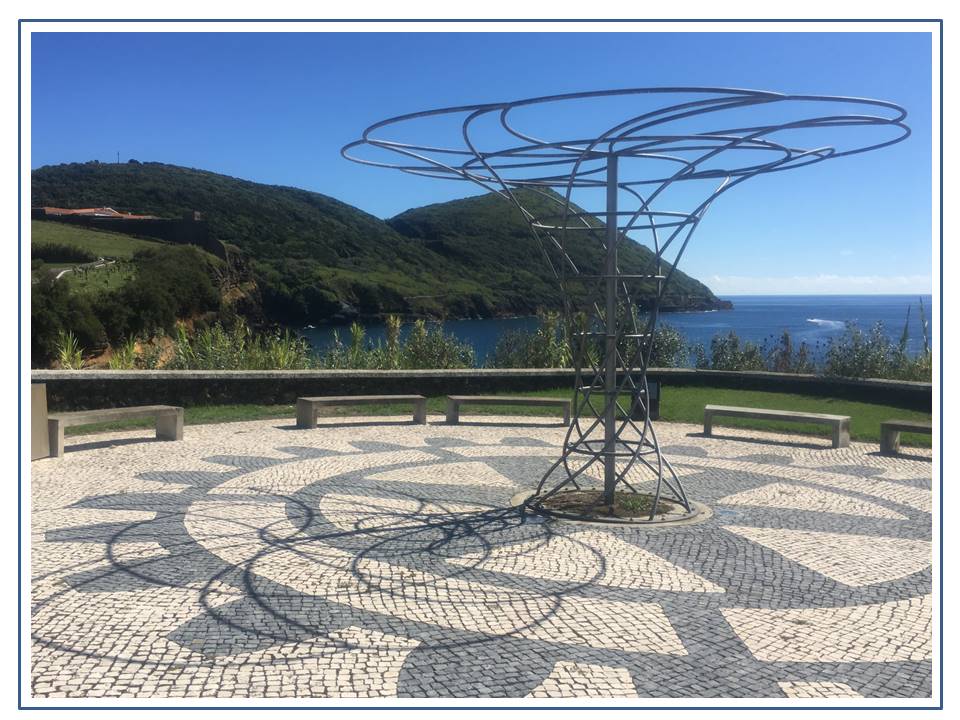
Caption: I really enjoy public art, especially when it grabs you at first sight – the Hurricane Sculpture at Angra Do Heroismo really grabbed my attention!
It was still officially hurricane season in the Atlantic and September and October are known to be active months. The Azores are well known for the fierce winter storms the North Atlantic can unleash and we had seen firsthand the destructive power those storms can pack. The breakwater at Madalena, on Pico Island was a good example – a massive mole of poured and concrete block, with a concrete tetrahedron fronted wall several stories high and so wide it had a two lane road on its harbor side. That mole was missing a section that you could put a 4 lane highway through and still have room for landscaping. It was breached from the power of the waves during a particularly strong winter storm. There were also pictures at a view point just west of Horta, on the island of Faial. The picture showed waves crashing and sending spray all the way up huge cliffs that were well over 50 m high. Naively, I had typically associated hurricanes with the Caribbean, Gulf of Mexico and eastern USA (or their Pacific equivalents), I had never really paid much attention to the fact that the Azores are known to have the hurricanes periodically pass through them as well, typically in the fall.
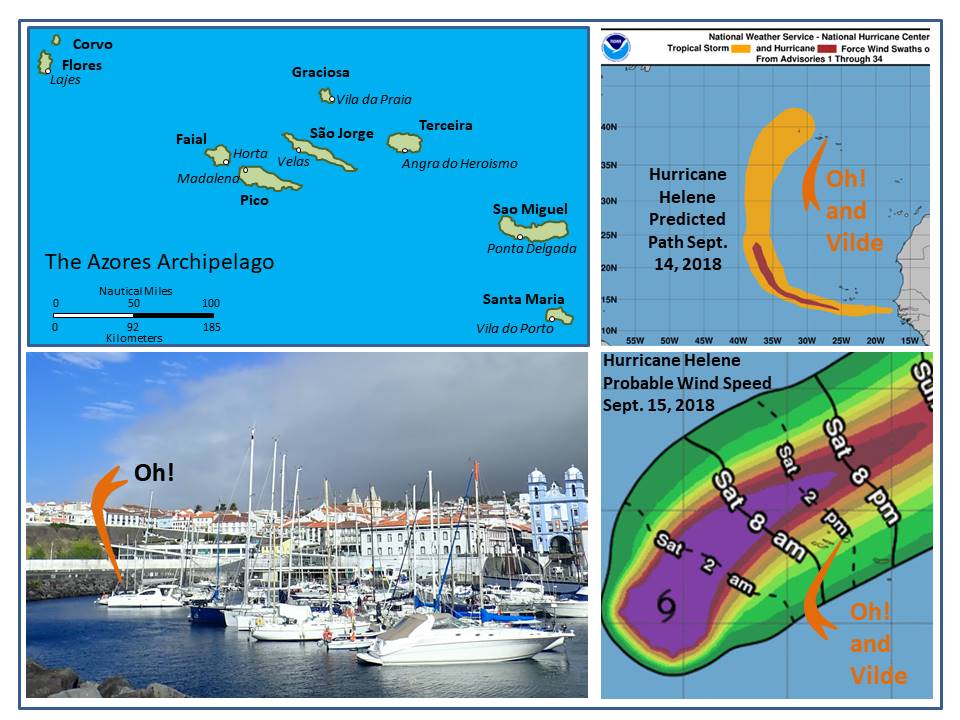
Caption: The Azores Archipelago. Hurricane Helene’s predicted path meant we needed to find a safe harbor – that meant Angra Do Heroismo, on Terceira Island. Oh! tucked far inside Angra’s well protected harbor prepares for a possible windy day as clouds from the outer edges of Hurricane Helene fill the sky to the west of Angra.
A low pressure that would eventually build to become Hurricane Helene first caught my attention on September 7th while we were anchored at Madalena on Pico Island. Over the next few days the low pressure system developed quickly just south of the Cape Verde Islands which is not unusual; except rather than a more typical westward path toward the Caribbean, the models showed a northwestern and northerly trend. To my inexperienced eye, that was really unusual and not good. That low was clearly something to keep an eye on, even though it was well over 1500 miles away. At the time we were enjoying touring Pico Island with our Norwegian friends. Within a few days it became increasingly clear that a whirlwind of change was coming our way – but the big question was where would it ultimately go, and more important – where should we go?
Our Norwegian friends Mona and Arno had spent a lot of time in the Azores during their first Atlantic circuit many years ago. They had always offered us a lot of good sound advice. Whether it was hiking, places we must see, or the best anchorages to visit, they were a trusted source. So I posed the question to them – “If you need shelter in the Azores where do you go?” They both simultaneously and without hesitation had an immediate answer, “Angra on Terceira Island”. The tropical storm that would become Hurricane Helene was still over 1200 miles away and its predicted path was still highly variable suggesting it would pass west of the Azores. However, the simple fact that the path would undoubtedly change over the next 4-7 days made it even more important to find suitable shelter. It can be difficult to get space for a catamaran in the Azores during high season or at any time in the smaller and most protected marinas. Therefore, I wanted to get to Angra while there might still be space to accommodate Oh!. Immediately our plans and cruising for the next 6 days from September 9th-15th were dictated by making sure we were in Angra Do Heroismo, on Terceira Island before September 10th. We would remain there until after it was clear Helene would either not visit the Azores, or had left. This meant cutting short our tour of Pico, but it was late in the season and we still had three islands to visit on my wish list, so the parting was bitter sweet.
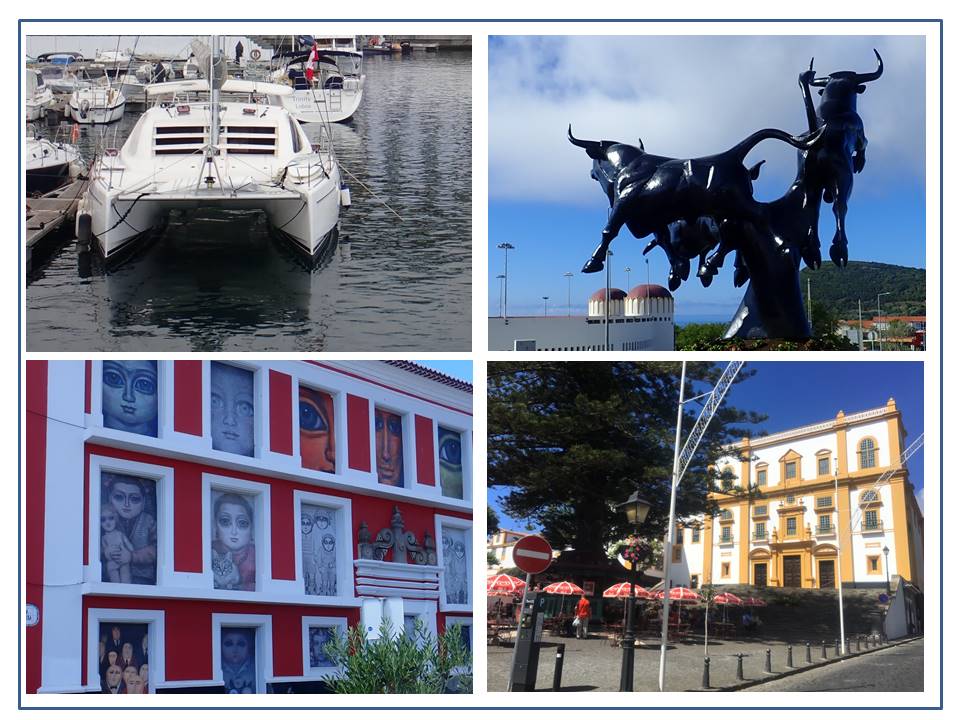
Caption: Canvas stripped, main wrapped and tied, – Oh! was moored to the “T” dock end with every fender we had and could borrow, snubbers on every line and an anchor set opposite to help hold us off the dock. The massive bull sculpture at Angra is at least 10m high. Street Cafés and a sampling of the beautiful public art throughout Angra.
The overnight passage from Pico to Terceira is just 90 miles and Oh! motored the entire distance in glassy calm seas. It was a warm late summer evening that was followed by yet another incredible star filled night sky and a gorgeous sunrise. As we approached Angra the seas were glassy and the morning was incredibly peaceful with simmering deep penetrating warmth in the air. Rather than go straight to the marina we decided to just drift; go for a swim in the warm crystal clear waters, scrape the minor growth off the bottom and enjoy a leisurely breakfast basking in the sun 3 miles offshore from Angra’s harbour. It was a fabulous morning and we enjoyed it immensely. An interesting phenomenom in the Azores is that the water is often warmer offshore than at the sea shore. This is probably due to the forced upwelling of deeper cooler waters near the steeply dipping coasts. After our morning of relaxing bliss we headed for the marina, refreshed and excited about another new landfall. Once checked in and assigned a berth, the next task was to check out the town.
Angra is a World Heritage City full of fabulous architecture, parks, pedestrian areas, café’s, and interesting art works. A beautiful city we could happily have spent a lot more time at. It quickly became our favorite Azores port of call. Two days later our friends Mona and Arno joined us there, as well as several other friends we had met while cruising the Azores. Our little community of cruising yachts representing a half dozen nations and every type of vessel was gathering. It was fun to enjoy touring the island, hiking, swimming, enjoying a few meals out and visiting with our friends as we enjoyed the “calm before the storm”. I always find it enlightening to actually expereince the meaning and roots of all those english idioms that are so common in our language. The 6 days spent waiting for Hurricane Helene were spectacular warm, clear and calm fall days. Perfect for exploring the island, attacking the “to do List” and enjoying the time with our friends. However, it was an odd feeling to be in such incredible weather while waiting for a potentially nasty storm to arrive. On several days you could clearly see the leading edge of the swirling cloud mass of hurricane Helene to the west of Angra.
Terceira island has plenty of interesting sights to see. It is another sheild volcano with multiple cones, a caldera, museums, a geothermal area, caves to explore, towering cliffs, volcanic vents, and of course, those beautiful seaside natural swimming areas. There are numerous hiking trails and parks to visits as well as plenty of interesting architecture. The island, like many of the Atlantic and Caribbean Islands we have visited, has a wide variety of climatic zones and vegitation based on elevation and exposure to prevailing winds and moisture; so the scenery is always changing and interesting. It is also the home of what was a large US and NATO air base that appears to be a lot less active than in the past. The airfield’s long runway is shared with the civil airport and can accomodate large aircraft. Therefore, the island has excellent connecting flights to Europe and North America. However, the airbase is a shadow of its former size in terms of personel and activity. As a result, the large community of housing around it resembles a ghost town. The lack of activity in the area surrounding the base gives it an air of silence that is out of place compared to the visual setting and the rest of Terceira.
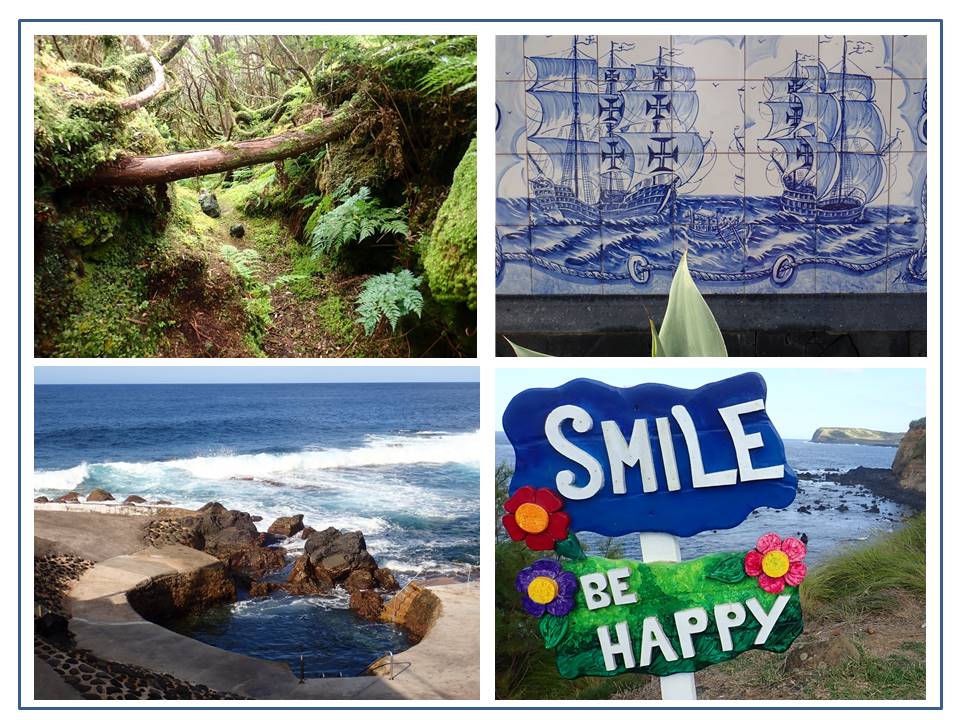
Caption: The hiking trail to Black Lake near Terceira’s thermal area was a spectacular “Fern Gully” of contorted trees and lush vegetation. Traditional blue and white tile mosaics are common throughout the Azores – note how tile columns 2 and 5 were mixed up! A sign above one of Terceira’s most scenic outdoor natural pools says it all. One of three natural pools at the location below the “Smile “sign.
While at Terceira we wanted to see the “Bull Fights”, Azorean style. This is not to be confused with the more famous Spanish running of the bulls, or bull fights. In the Azores the bulls are never harmed and come back weekly to get a little exercise chasing the tourists and testosterone charged men who taunt them. The Bull Fights seemed more like an excuse to have a village party and have people from all over the island come to socialize. On the other islands we were informed on several occasions that “all the people do on Terceira is party”, so I guess they have a reputation to uphold. Anyway, it was fun and a great opportunity to enjoy a unique Azores tradition watching the crowds clearly enjoying the opportunity to mingle, quaff beer and enjoy the event as they appeared to be cheering mostly for the bulls!
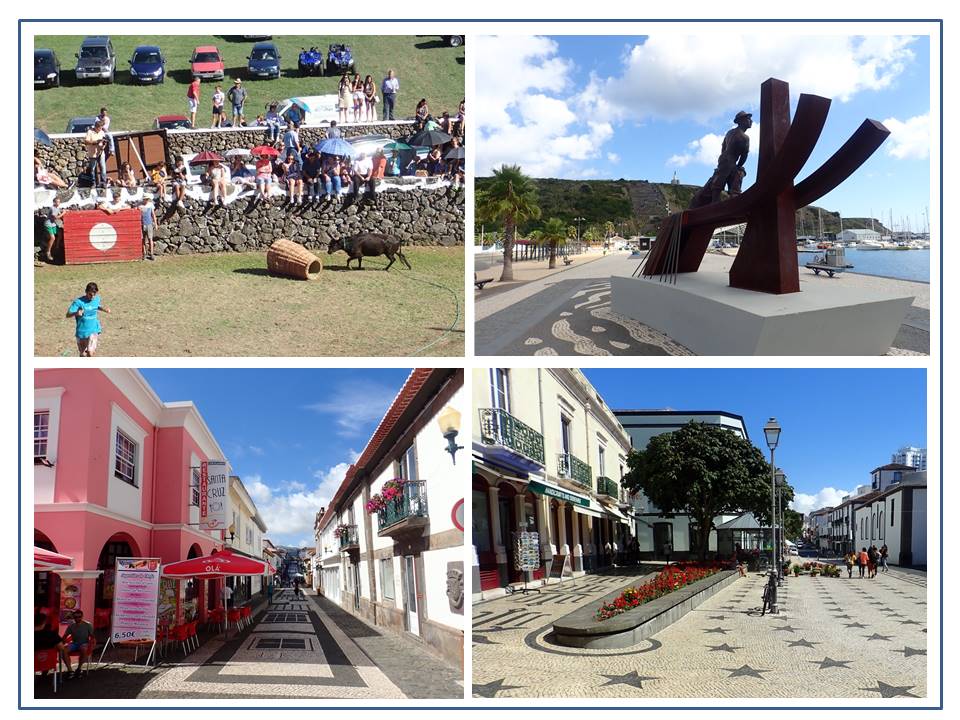
Caption: A running of the bulls Azores style. The beautiful waterfront promenade at Praia do Vitόria – arguably the best anchorage in the Azores. Beautiful mosaic rock pedestrian streets in Praia Do Vitόria.
The one area we wish we had time to visit by boat was the beautiful harbour at Praia Do Vitόria on Terceira’s eastern coast. The harbour is very large and well protected by two large moles. The south end is industrial, but the north end is one of the nicest and best protected anchorages we had seen in the Azores. There is a beautiful sand beach, excellent marina, waterfront promenade, and the town of Praia is colorful and interesting. The surrounding area also has some readily accessible hiking that affords spectacular views of the island and city. We could easily have spent a week on anchor enjoying this area. A definite must for the next time Oh! visits the Azores.
By September 16th, Hurricane Helene had come and gone and thankfully only brought some high winds and larger waves for one evening. Protected inside Angra Do Heroismo’s large mole, even the waves that refracted within the harbour only amounted to a night of fenders complaining and squeaking loudly as they were heavily compressed the dock and Oh!. However, the western Islands of the Azores were not as well off and our decision to move to Angra had been a good one. Our extended stay in Angra meant we were running short of Schengen days (non-Europeans are only allowed to stay in Europe for 90 out of any 180 day period). It also meant weather windows for moving south were getting shorter and more intermittent. Therefore, it was once again time to move on.
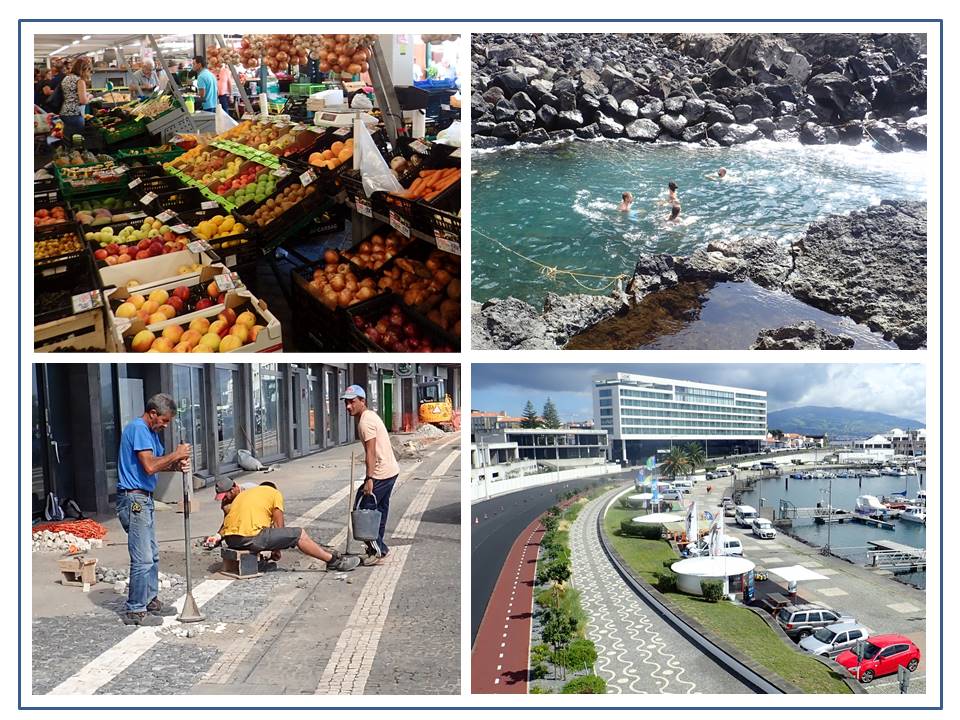
Caption: The Market in Ponta Delgada was a beehive of activity, one of the best we have seen anywhere. The thermal inlet at Ponta de Ferraria, a “hot tub in the sea”. The waterfront promenade at Ponta Delgada. The amount of work involved in creating all those beautiful mosaic streets, malls and plaza cobblestone patterns, is mind boggling.
São Miguel Island is the most populated in the Azores and the main city of Ponta Delgada has a distinctly large city feel to it. It is the only city in the Azores with multiple modern high rise buildings that cast their shadows over the older and much more interesting historical buildings. The mix of old and new is a stark contrast between the elegance of the old buildings and stoic geometric designs and hard corners of the modern towers. Fortunately, Ponta Delgado still retains a lot of its charm and beauty. There are many pedestrian malls, a wide promenade along its waterfront, the new marina facilities, a dedicated swimming area complete with beach, large pools, change areas, cafes, and a long waterfront mall. As you explore deeper into the city there are many parks and plazas among the beautifully restored old city, plus miles of hand laid mosaic streets and walkways to explore.
Upon arrival at São Miguel, yachts are required to clear in through Customs and Immigration. The same procedure is required at all three official clearance points in the Azores, regardless of whether you have already cleared into one of the other islands. I welcomed these short visits, as it gave me a chance to chat with the officers about what would be their favorite thing to do, or place to visit on their island? In Ponta Delgada the officer instantly replied, “Do you enjoy good beef?” I am from Alberta, the heart of the Canadian beef industry, so the answer was an emphatic “Yes!”. “Then you must go to the Agro Center and enjoy a dinner of the finest beef in the Azores,” was his reply. We took his recommendation seriously and as part of our tour of the island, we stopped for dinner and enjoyed the best beef I have had since leaving Calgary some 12 months earlier. It seemed out of place to arrive at a stock yard, slaughter house and shipping center and then walk into an industrial style warehouse for dinner. However, once inside there was a very large, beautiful and very full dining area serving a lot of smiling faces. We enjoyed a savory memory of another beautiful island in the Azores and made a trip back to Immigration the next day just to thank the officer for his wonderful recommendation.
I had initially thought Ponta Delgada might be a good place to find refuge from Hurricane Helene since the island is farther east than Angra and Terceira and further east from the hurricanes predicted paths. However, while on Pico Island, our friends Mona and Arno quickly discouraged that idea, and with good reason. The marina that the transient yachts must use is exposed to a lot of ocean swell that refracts around and under the bridge-like dock used by the cruise ships. Even in relatively calm weather, the boats in the marina are subject to a lot of motion at the floating docks. After a single night in the marina, the reasons to pick Angra over Ponta Delgada were very clear.
It was now September 30th and we had to start making miles south to the Madeira Islands as the weather had a very distinctive cooler fall feeling. Sadly, I decided we would have to pass on the final island in our Azores tour and after clearing out, set sail late that evening for Santos in the Madeira Islands. Under partially cloudy skies and brisk NE winds we headed out to sea to leave the Azores.
Ugh, maybe not so fast…on the second day of our passage about 159 miles southeast of São Miguel, we encountered a big line of squalls. Just 10 minutes after we tacked to avoid a particularly large squall, our starboard inner shroud broke at the T-Hook where it attaches to the mast. That now made two identical T-Hook failures in just 10 months on the new standing rigging we had replaced in Martinique. A quick look at our position and the distance remaining to the Madeira Islands indicated we might be able to motor the remaining 400 nmi., but any reaching or beating to windward with a broken inner shroud under sail would not be an option. After trying to motor for 12 hours reaching to windward, it quickly became apparent we would not have enough fuel and we were fed up with living in a washing machine on agitate while aggravated by the constant sound of the engine straining to give us just 2-3 knots of headway. Thankfully, our friends at Mid Atlantic Yacht Services (MAYS) had responded to our IridiumGo! Email message we had sent when the shroud broke. They confirmed they could fabricate a new shroud within just a few hours of receiving the broken shroud at their shop in Horta, on Faial Island. The only delays would be shipping, which could be overnight shipping between Faial and Santa Maria just 100 miles to the west of us; or 3-4 weeks for shipping if we preceded to the Madeira Islands.
The decision was immediate, Santa Maria Island here we come! With that decision it only took a minute to about face and change the “washing machine on agitate” ride in Oh!, to a silk carpet as we motored on a deep broad reach back to Santa Maria. Our speed over ground jumped to 7 knots as the following seas gently lifted Oh! and rolled beneath us and… we were going to get a chance to visit the last of the Azores Islands. Yes, every cloud has a silver lining; I think I said that earlier in this article as well!
There is quote that is frequently attributed to Goethe, the Dutch Philosopher, although he apparently did not write it that is titled “Commitment”. I have it framed in my home in Calgary. In a nutshell, it basically says that until you commit to something, you will never know all the unforeseen circumstances, forces and assistance you will encounter that will help drive you toward your goal. I have experienced that over the course of Oh!’s Atlantic Circuit on many occasions. Mr. Goethe ( or whomever actually wrote the quote) was absolutely correct.
The 100 miles to Santa Maria flew by and we arrived in time to remove the broken shroud and T-Hook attachment plate to get them shipped to Horta the same day. The lady that helped me at the airport shipping terminal was simply incredible. She told me she would personally make sure the cable went out that night. If for some reason the cable missed that flight, or there was any delay, it would miss the last connection in Ponta Delgada for the flight to Faial and there would be no chance of receiving it before the approaching holiday long weekend. The push was on to get it to Faial so that MAYS could duplicate it and get it back to us before the airline commercial shipping terminals in Faial and Ponta Delgada closed for the long weekend. Not only did the MAYS staff go personally to meet the arriving flight in Faial to pick up the broken cable, they also duplicated it and got it back on the very next flight in just a few hours for the return trip to Santa Maria. The service I received from the staff at MAYS was also incredible.
Unfortunately, the return trip required an overnight layover in Ponta Delgada that was unavoidable. That meant it would get to Santa Maria on time, but I would not be able to pick it up for 3 more days due to holiday weekend shut down. The Santa Maria commercial shipping terminal closed at 5pm but the incoming flight arrived at 8 pm. No problem, the wonderful lady that helped ship the cable out told me that if MAYS managed to get the cable to the Santa Maria airport on that exact flight, she could make it work. She asked me to let her know if the cable would be coming back as quickly as hoped and if it was, I could meet her at the passenger reception for the incoming flight. She would be working that evening as part of the ground crew. Therefore, she could personally open up the closed shipping and receiving building to deliver me the new cable since she needed to check in the arriving parcels as part of her shift. In just 72 hours Oh! had a new starboard inner shroud in my hands – incredible! The final piece of the puzzle was getting it riveted and installed in the mast. Ricardo Botelho, (the owner of Nauti-Botelho, the local boatyard) assured me if I received the cable no later than the holiday Friday night, he and his technician would come by Saturday morning to rivet the T-hook socket back into the mast. We had been told by several yachts and websites that Nauti-Botelho had great service and did very good work, especially on fibreglass repairs. They certainly lived up to their reputation. Thanks to the help of some key people on Santa Maria and at MAYS on Faial, the comment on “Commitment”, was spot on!
Once again we were all set to make our second departure for the Madeira Islands. Ugh, maybe not so fast…
The arrival in Santa Maria to get the shroud repaired was a very focused effort. The push to get the repair done was because I could see another low pressure system developing in the Atlantic that was forecast once again to become a hurricane, very similar to Hurricane Helene. However, it was developing in the mid-Atlantic southwest of the Azores and would presumably go north or northwest. By Saturday Oct 6th, when the shroud was finally re-installed those thoughts were gone and the direction of what would become Hurricane Leslie became a huge question mark. Do we depart for the Madeira Islands right away, or stay? Unfortunately, as each new forecast became available, the predicted path of Hurricane Leslie just became more scattered and unpredictable. Like Medusa’s hair, Hurricane Leslie had potential to go snaking off in any direction. As I read the analysis and warnings from the NOAA site, it was clear even the forecasters were really struggling with where this swirl of high energy activity would go. They were openly expressing and admitting frustration about trying to make any reliable path predictions. How do you predict the path of something that was essentially stationary – and the storm stayed that way for over 5 days frustrating the forecasters and making me very reluctant to leave the snug little harbour of Vila do Porto. The potential paths included all of the Azores, the Madeira’s, Portugal and potentially even parts of the Canary Islands, which made a move in any direction too risky.
So what do you do when you can’t figure out what to do? Well, a pot luck dinner with all the other cruisers who were also wearing out their finger nails scratching their heads over Hurricane Leslie would be a good place to start. It doesn’t take long for a half dozen cruising boats in a small marina to get to know each other and there was a perfect spot at the head of the marina with picnic tables and a nice view of the harbor to enjoy an evening of favorite dishes and treats from around the world. Our group had representation from the Netherlands, France, Norway, Spain, U.S.A, England, Finland, Canada and a special representative from the canine world enjoying our gathering. In the end, the weather issues remained unresolved – but we had a great evening!
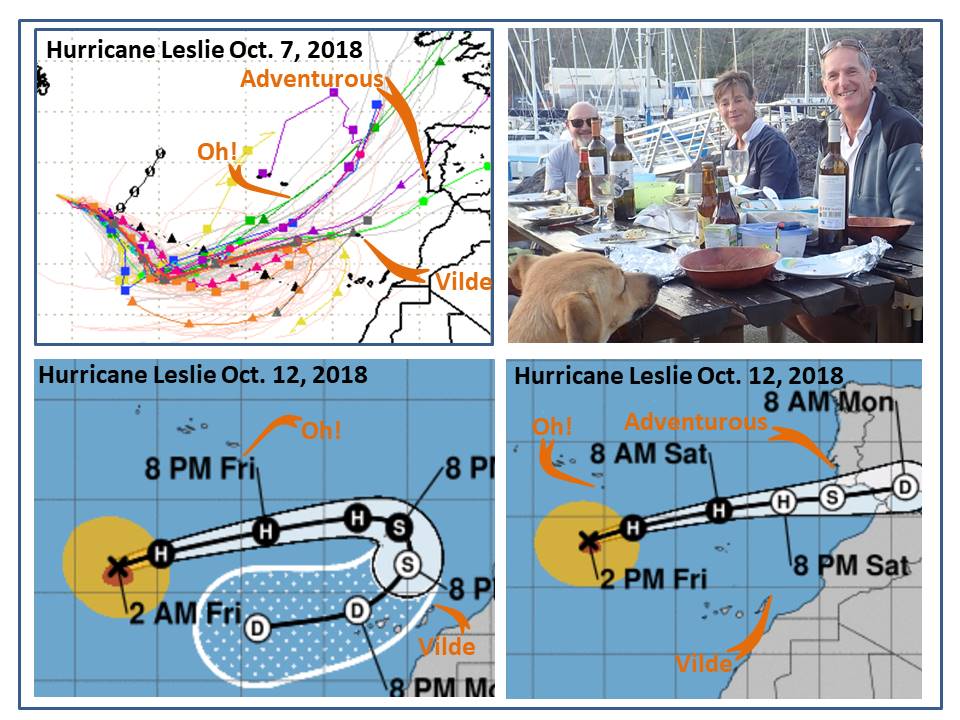
Caption: A spaghetti plot of Hurricane Leslie’s potential path predictions. A pot luck cruisers dinner to chat about the weather of course! The crazy forecast path predictions of Hurricane Leslie that were just 12 hours apart. The hurricane eventually decided Friday at noon on Oct. 12th to make a rifle shot to Portugal, sparing the Atlantic Islands.
Santa Maria is the south eastern most island of the Azores and much like Flores in the northwest, it retains a charming, more rural setting. The landscape is varied with open pasturelands, treed slopes of the higher elevations and steep cliffs along the northern shores. Like all of the Azores, the scenery is spectacular with the deep greens of the land and multi colored blues of the sea creating picture perfect vistas in every direction. As we waited for the “hurricane with no sense of direction” to figure out its life, we took time to do “boat list” stuff and also tour the island and do several hikes. Our favorite hike was a segment of a much longer one we would like to come back and complete one day. An entrepreneurial man has renovated four traditional stone dwellings into hiker’s lodges. The lodges break up a hike around Santa Maria Island into four segments. If you plan far enough in advance you can book for a succession of four nights, allowing you to hike around the island with minimal gear and enjoy luxurious accommodations. If you add the meals package, you arrive to a home cooked meal and a different beautiful cabin each night. Not surprisingly, his business is becoming very popular. Unfortunately, it may be threatened as a large area that they currently hike through is potentially going to become part of a new space port for the European Space Agency to launch satellites. That may close off a large segment of one of the trails that passes through some of the most picturesque areas of Santa Maria.
Our hike along one segment of that trail led us past abandoned limestone quarries filled with fossil beds, volcanic plugs and cinder cones, farm fields, along cliffs with stunning vistas, and through forests filled with the sound of song birds. It ended near an incredible set of tiny, picture perfect secluded beaches. It was one of those places that just welcomed us into the warm clear waters to enjoy the surf and bask in the penetrating heat of the late afternoon sun. What an amazing day! The owner of the huts told us that the best hikes were on the other side of the island – It is hard to imagine how they could beat the one we enjoyed. I guess we will just have to go back and complete the island circuit to find out. It was now Oct 14th and our quick stop in Santa Maria to get the shroud repaired had stretched into its 12th day. With Hurricane Leslie finally no longer a threat to us, we could safely depart for the Madeira Islands. Unfortunately, over the space of just 12 hours Hurricane Leslie became a very real threat to our Australian friends David and Mary 800 mi northeast in Portugal. A quick WhatsApp note to them warning of the hurricanes potential path had them scrambling to find a suitable place to secure Adventurous. Fortunately, they were successful.
Tick, tock, tick, tock; that was the sound in my brain of the Schengen clock. We were close to using up our 90 days in Europe and had to get moving. The Madeira Islands were calling.

Caption: The mosaic tile work in Santa Maria was the most artistic we had seen in the Azores. Last of the year’s harvest – freshly picked grapes, yummy! After a hot but beautiful cliff side hike, this deserted and private little beach was calling us for a swim. The green fields of Santa Maria with a massive squall on the horizon – change is definitely in the winds for quiet and beautiful Santa Maria.
Oh!’s time in the Azores was originally planned to be 3 weeks out of Oh!’s Atlantic circuit around the Azores, Portugal, Spain, Morocco, the Madeira and Canary Islands. However, I had now spent 73 days in just the Azores and enjoyed every moment. To their credit, every Azorean person we met was warm, welcoming, and incredibly friendly. The islands in the archipelago were all created by identical geological processes, yet each has a very unique range of attractions, geology, geography and almost micro-cultures that are so engrossing I did not want to leave any of them. The close association to the European Community has clearly benefitted the Azores, and it shows in the quality of roads, services, variety of foods available and living standards on the these islands that are 750 nmi. from Portugal. Litter and graffiti were almost non-existent, and even the well-marked trails would frequently have not only garbage disposal bins at the trail heads, but also a full set of recycling bins! The Azoreans clearly have great pride in their history and past expertise as whalers during a very different era. There resilience shines in seeing how they have reshaped that expertise into a premiere destination for whale and dolphin watching eco-tours. There are active programs and incentives for industrious persons to immigrate to the Azores to re-build their once extensive and highly sought after wine industries and agricultural resources. Add to that a Portuguese history going back six hundred years with very little war damage and no readily apparent cultural friction within their community – and the Azores almost have it all. They just lack abundant natural bays and harbors to anchor in. Yet even that is a relatively minor issue as they have built many harbours with large moles and a well-managed system of marinas where visiting yachts are openly welcomed and at reasonable prices.
Now… if they would just stock Hazelnut crème for my coffee…I might never have left!
The Azores are truly “SPECTACULAR”.
To be continued in “Postcards from an Atlantic Circuit Part 8 – The Madeira Islands.”
References from: Atlantic Islands Sixth Edition – RCC Pilotage Foundation, Imray books. Authors Anne Hammick and Hilary Keatinge
Hurricane Weather predictions and graphics are screen shots from the NOAA Website. (National Oceanographic and Atmospheric Administration).
About the author: Rod Morris
SV Oh! 2006 Robertson and Caine Leopard 40’ Catamaran
Website: www.cloudstocoral.com
Biography
Rod has been sailing Oh! throughout the eastern Caribbean for the past three seasons offering people the chance to ”Sample the Cruising Lifestyle” and is currently completing an Atlantic Circuit. He has enjoyed 8 Caribbean passages and 3 Atlantic Passages (including 1 solo) over the past 10 years. You can follow the travels of Oh! on Instagram at: sv_oh , or find out how you can join Oh! through the website: www.cloudstocoral.com. Rod is a Professional Geologist, Glider Pilot and RYA Yacht Master (Offshore) and a member of the Blue Water Cruisers. He can be reached at info@cloudstocoral.com
